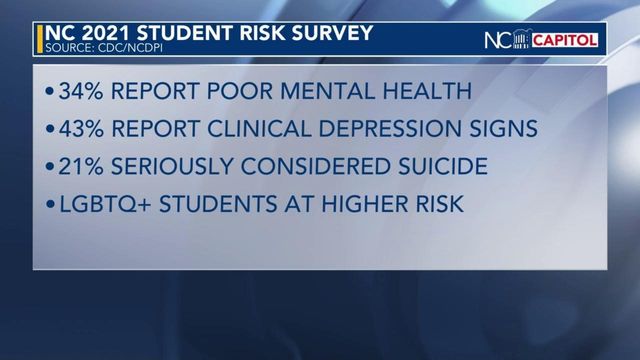Depression, violence, access to guns rising among NC students, data show
A child welfare panel in North Carolina got its first look at the latest student risk behavior survey. The data paint a bleak picture of student mental health, access to guns, and violence.
Posted — UpdatedThe 2021 Youth Risk Behavior Survey, a biennial poll that originates with the national Centers for Disease Control, was voluntary but taken last fall by a statistically significant sampling of middle- and high-school students across the state. Ellen Essick a section chief with the North Carolina Department of Public Instruction previewed the latest numbers to the Child Fatality Task Force at its meeting Monday. Among the results:
- Only 49% of students reported feeling good about themselves, down from 60% in 2019, and continuing a steady downward trend since 2011, when 80% said they felt good about themselves.
- Reports of depression also rose sharply. When students were asked whether they had stopped their normal activities for two weeks or more due to sadness in the past year — a sign of clinical depression — 43% of high-schoolers said they had, compared with 36% in 2019.
- Overall, one in three students said their mental health was not good either most of or all the time. Girls were more likely to say that than boys. And students who identified themselves as LGBTQ+ or questioning were more than twice as likely to report poor mental health as students who identified themselves as heterosexual. Among LGBTQ+ students, those reporting seriously having considered suicide jumped from 44% in 2019 to 48% in 2021, compared with 15% of all heterosexual students.
- Reports of suicidal thoughts and self-harm also increased. More than one in five students reported they had strongly considered suicide in the past year, up from 19% in 2019. The increase, Essick said, was primarily in girls. "If you look at 2011 for males, 14% of males seriously considered suicide, and in 2021 it's still 14% of males," Essick said. "But in 2011, it was 15% of females and that's jumped to 30% of females in 2021."
- Twenty-two percent of all students reported doing something to hurt themselves without wanting to die, also known as self-harm. Among LGBTQ+ students, that number was 49%.
While the survey comes from the CDC, states have some ability to customize the topics. Schools could choose not to participate, parental consent was required, and students could choose not to answer some or any questions. Neither parents nor school staff were privy to the results, which experts say encourages students to answer honestly.
Guns and violence
In a question asked for the first time in 2021, 30% of students said they could obtain a loaded gun within an hour without their parents' knowledge.
Boys were more likely to report access than girls, older students were more likely than younger students, and white students were twice as likely as students of color to report ready access to a loaded firearm.
Seventeen percent of students said they had not gone to school at least one day in the past month because they felt unsafe there, on the way there or on the way home. In 2019, that number was 14%.
"We don't know what's behind that," Essick said. "Are they feeling unsafe because of school shootings? Are they feeling unsafe because of COVID? We don't know why students are necessarily saying they feel unsafe at school. But what we do know is, it's an increase."
And 13% of students reported experiencing violence in a dating relationship, a marked increase from the 7% who reported that in 2019.
Mixed news in other areas
The percentage of students who reported texting or emailing while driving was 40% in 2021, up from 36% in 2019.
Vaping appears to have declined since 2019. Thirty-eight percent said they had tried it before, down from 52% in 2019. And 24% of students reported regular use of vaping products in 2021, compared with 36% in 2019.
Reports of feeling bullied also declined among high-school students, but increased in middle-school students, Essick said, especially electronic or online bullying.
Essick said she plans to unveil the full report, including middle-school data, to the State Board of Education at its Jan. 4 meeting. After that, she said, it'll be posted on DPI's website.
Related Topics
• Credits
Copyright 2024 by Capitol Broadcasting Company. All rights reserved. This material may not be published, broadcast, rewritten or redistributed.






